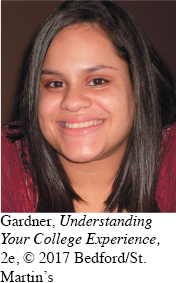Student Profile with Introduction
PROFILE


Irene Ramirez, 25
Early Childhood Education Major, Community College of Rhode Island

Irene Ramirez was born in New York City and spent most of her childhood in the Dominican Republic, where she also went to high school. After graduating, Irene returned to the United States to attend college. She first started at a community college but left at the end of her first term when she decided to get married. Recently, she decided to re-enroll in school and again chose to attend a community college because of smaller class sizes and more personal instruction, which she values highly, both as a student and as a mother raising two small children.
“It took me a long time to figure out how it was easiest for me to learn, but I finally did, and I use the learning strategies that work for me.”
“It isn’t easy being a mom, a wife, and also a full-time student,” Irene explains. “Time is the hardest thing to find when you have toddlers, but they are my motivation.” Irene uses a number of strategies to maximize her time and do the amount of reading expected in college. “I take small chunks of time and get the work done. I use my children’s nap time as study time. I know nap time gives me at least two hours to go over an assignment.” She uses those small blocks of time to learn. “If I don’t have a lot of time, I skim over the material. When I have more time, I highlight the things that stuck in my head and identify main ideas.” Irene also types her notes. “That way,” she explains, “my mind focuses on the material more so than when I just read it. Even if I don’t remember something after reading it, I’ll probably remember it after typing it.” Most important, though, Irene is careful to give herself enough time to learn the way that works best for her. “It took me a long time to figure out how it was easiest for me to learn,” she says, “but I finally did, and I use the learning strategies that work for me.”
Irene’s one piece of advice to other first-year students is: “Always read before you go to class, even if it’s just before going in. Material will make a lot more sense when you have seen it once before. You will be able to better understand concepts, and you won’t forget main ideas.”
After graduating from the Community College of Rhode Island, Irene plans to work as an early childhood teacher. She has also set a long-term goal of managing a daycare facility. Irene isn’t afraid of dreaming big. “If I set out to do something, I have to give it my all,” she says. “That’s my expectation for myself.”
As Irene suggested, reading college textbooks is more challenging than reading high school texts or reading for pleasure. College-level texts are full of concepts, terms, and complex information that you are expected to learn on your own in a short period of time. To accomplish this, you will find it helpful to use the active reading strategies presented in this chapter. They can help you get the most out of your college reading.
Depending on how much reading you did before coming to college—reading for pleasure, for your classes, or for work—you might find that reading is your favorite or least favorite way to learn. Even if reading isn’t your favorite thing to do, it is absolutely essential to doing well in college and at work—no matter what your major or profession might be.